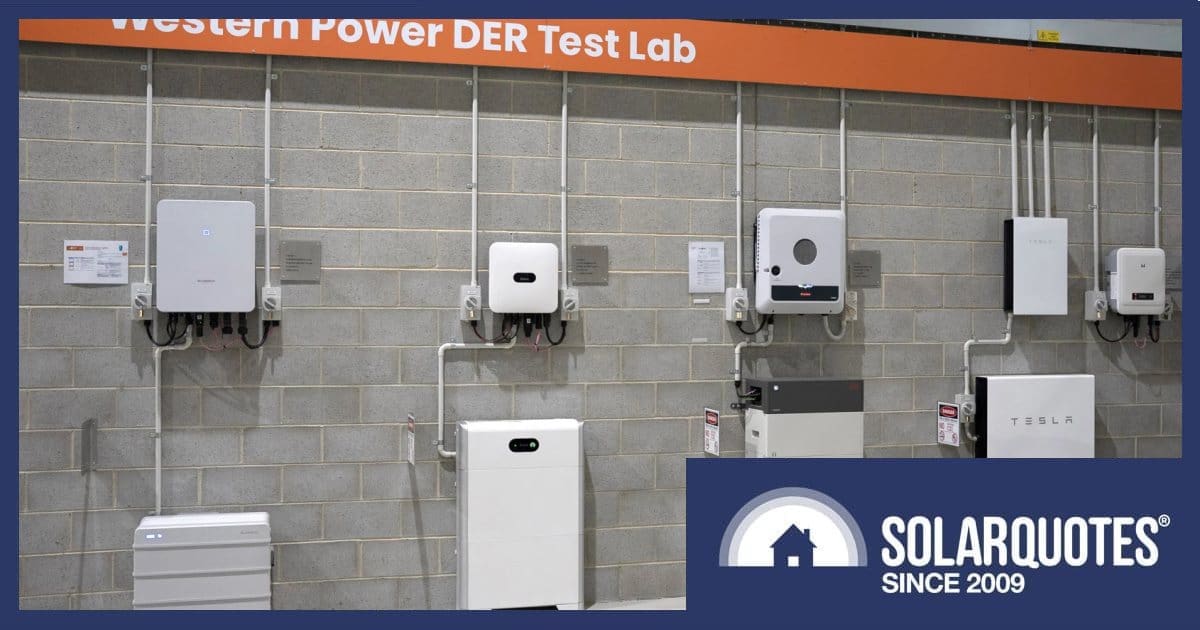WA electricity distributor Western Power has launched what it says is the first dedicated Distributed Energy Resources (DER) testing lab in Western Australia.
What’s The Purpose Of The DER Test Lab?
The facility will trial how customer-owned energy technologies such as solar, batteries, EVs and smart appliances, related control systems and integration methods perform in real-world network conditions before being deployed in the field.
By simulating real-world conditions, the DER Test Lab will be assessing interoperability, performance and compliance across devices and systems.
“The lab gives energy partners a space to address the technical challenges of integrating DER into a network that was not designed for two-way energy flows,” said Western Power’s Matt Cheney.
The facility is situated at Western Power’s South Metro Depot in Forrestdale, around 30 kilometres south of Perth.
Western Australia’s South West Interconnected System (SWIS) is the biggest isolated grid in the world. Stretching from Kalbarri in the north, to Kalgoorlie in the east and Albany in the south, the SWIS serves 2.3 million customers. As it is isolated, the SWIS cannot share or draw power with/from other states, and managing the growing amount of DER within the SWIS has become a more challenging balancing act.
Informing Project Jupiter
The insights from the lab will also inform Project Jupiter, which aims to accelerate the integration of rooftop solar and batteries into WA’s electricity system through virtual power plants (VPPs). The Australian Renewable Energy Agency (ARENA) awarded Western Power $20.8 million in funding for Project Jupiter early this year.
“As more solar, batteries and EVs connect, it is vital they do so safely and in a way that enables participation in opportunities such as virtual power plants, allowing customers to unlock more value from their assets while supporting the energy transition,” said Cheney. “The DER Test Lab is a practical and collaborative way to overcome barriers to DER integration.”
Project Jupiter is a collaboration between Western Power, Synergy, the Australian Energy Market Operator (AEMO), and Energy Policy WA
“It is an exciting time for DER integration at Western Power, and the DER Test Lab is playing a vital role in ensuring we and our partners get the technical settings for DER orchestration that will support customer participation in the energy transition at scale.”
Establishing such a facility was one of the recommendations in the Project Symphony Final Report. Running from July 2021 to February 2024, the Project Symphony pilot orchestrated approximately 900 DER across 500 homes and businesses in Perth into a Virtual Power Plant. The project sought to understand how VPPs could unlock benefits for participating customers.
VPP Participation Still A Hard Sell
As for choice of VPPs in Western Power’s service area, there’s little at present — Synergy’s Battery Rewards and the Plico Energy VPP. And one of the barriers to VPP adoption has nothing to do with technical challenges, but consumer perception; with some wary of giving control over their battery to a third party, or unimpressed with the state incentive and/or benefits the VPPs currently offer.
But there’s certainly plenty of potential.
The popularity of home solar power in Western Australia has seen more than 551,000 PV systems installed across the state to date. And home battery uptake has really accelerated in recent months thanks to the national Cheaper Home Batteries Program (CHBP) and to a lesser degree, the WA Residential Battery Scheme.
Demonstrating the level of VPP hesitancy among WA solar owners, out of the 10,575 batteries installed and commissioned in Western Australia since July 1 this year to the end of October, it appears only around 4,500 have been installed with the added assistance of the WA Residential Battery Scheme. The state incentive offers an up-front discount on eligible battery systems of up to $1,300 in the Synergy area and requires VPP participation; whereas the CHBP only requires systems be VPP-capable. Another thorny issue is the originally announced rebate amount was reduced.
One of the desired outcomes of Project Jupiter is customer choice will be improved by increasing the VPP products and services available in Western Australia.


 RSS - Posts
RSS - Posts



One of the ways they could make VPP’s more attractive would be to untie them from the battery owners electricity supplier. IE allow them to sell access to their battery separate to whom ever they are contracted to, to buy their own power needs from ( whom they are paying their grid connection fee to as well of course).
In WA there are only two suppliers of power to domestic and small power users one for The country areas and the other for city customers which makes yout point moot.
Why again would I share my battery for free and then take the risk of increased wear and tear. It’s just a really bad deal currently for battery owners.
They pay 70c/kWh and $1300 upfront.
Oh wow — just up the road from me. Great to see WA investing in a dedicated DER lab. I’d understood ANU was taking the lead nationally on CSIP-AUS compliance, but I guess this complements that by tackling WA’s unique challenges with VPP integration and our isolated grid.
With the DER consultation now closed, it’ll be interesting to see how the outcomes shape things here — hopefully with a stronger focus on export limits rather than generation limits, and on VPP models that reflect what consumers are actually comfortable with – perhaps by allowing a choice of level of VPP participation through setting sell prices, rather than just handing over control of the whole kit.
I would like to see VPP available to any size system in WA. Currently many larger systems are permanently export restricted to 1.5kw due to the market rules which means a lot of solar energy is being curtailed straight to ground whether the grid can take it or not. I don’t think many people are aware of this waste.
Some us like me are just bitter and annoyed with the broken original promise. I haven’t forgotten the broken election promise and the lies that followed and the attempted gas lighting.
Now, the real issue is also the that they have surviving clauses in their VPP contract post end date. Ability to control your entire battery system still and they are not clear about how or when they use/abuse this. Other than trust us bro we got this.
On top of that BS they also want control of my entire battery stack. So when I buy 50kWh, you give me a tiny $130/kWh capped at 10kWh and you want control of the entire stack? How about a big fat NO. If I had the option to give control of just 10kWh of the 50kWh sure why not but since Labor and Synergy/Western Power want to get the most for next to nothing then well…we see how well the WA scheme is doing. $1300 on a $45,000 invest thanks for nothing since it is essentially that…nothing.